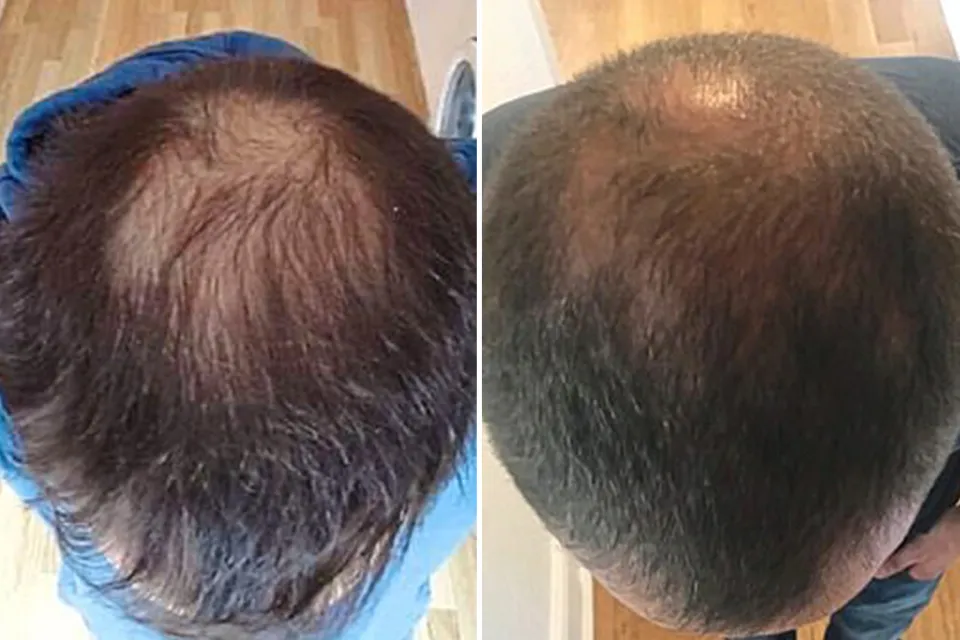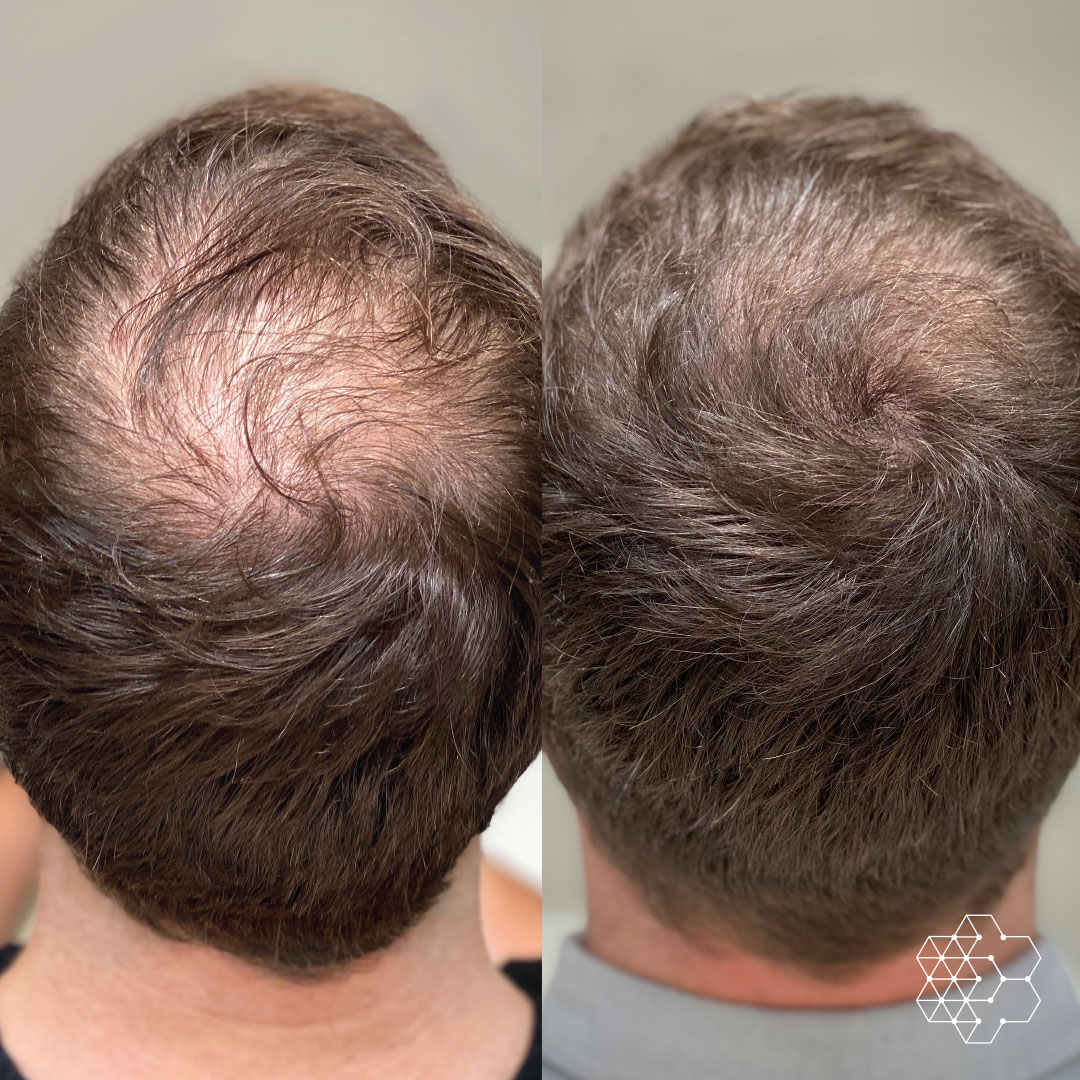Understanding Hair Loss
Common Causes
Hair loss, known medically as alopecia, affects millions worldwide. It can stem from various factors, including genetic predisposition, hormonal imbalances, and specific medical conditions. Many individuals experience thinning hair as a natural part of aging, while others may face more pronounced baldness due to inherited traits.
Genetics play a crucial role in male and female pattern baldness, leading to receding hairlines and bald areas on the scalp. Hormonal changes, particularly those associated with pregnancy, menopause, or thyroid problems, can also contribute significantly to hair thinning. Moreover, certain medical treatments like chemotherapy can cause temporary but severe hair loss.
Psychological Impact
The effects of hair loss extend beyond the physical. They deeply impact an individual’s psychological well-being. For many, a full head of healthy hairs symbolizes youth and vitality. Losing it can trigger profound emotional distress.
Studies have shown that individuals suffering from significant hair thinning often experience lowered self-esteem. They might feel less attractive or prematurely aged. This perception can lead to social withdrawal and anxiety, especially in environments where appearance is emphasized.
Diagnosis Importance
Identifying the exact type of hair loss is pivotal for effective treatment. Not all hair loss is permanent or progresses in the same way. Conditions like telogen effluvium cause temporary shedding due to stress or illness but usually resolve without intervention.
For more persistent forms of alopecia, such as female pattern baldness or areas experiencing shock loss after surgery, professional diagnosis is essential. Dermatologists can determine the underlying cause through examinations and tests. This step ensures that treatments target the specific issue at hand rather than applying general solutions that might not be effective.
Exploring Hair Transplant Techniques
FUE Method
Follicular Unit Extraction (FUE) involves individual hair follicle removal from the head. It’s less invasive than other methods. Patients prefer it for its minimal scarring and quick recovery time.
Doctors use a tiny punch tool to extract each follicle. This technique allows for a natural-looking hairline. However, it can be time-consuming and costlier due to the meticulous process.
FUT Method
Follicular Unit Transplantation (FUT) requires removing a strip of skin from the scalp. From this strip, doctors harvest hair follicles.
This method is faster than FUE and often cheaper. Yet, it leaves a linear scar on the head. It suits patients who prefer longer hairstyles that can hide the scar.
DHI Technique
Direct Hair Implantation (DHI) uses a specialized tool to implant hair follicles directly without prior extraction holes.
It offers enhanced control over depth and direction of the implanted hairs. This results in a more natural appearance and density. DHI is ideal for detailed work, such as enhancing the hairline or adding density to specific areas.
Suitability
Each technique caters to different types of hair loss and patient preferences.
-
FUE suits those seeking minimal downtime and scarring.
-
FUT works best for covering large bald areas efficiently.
-
DHI is perfect for patients desiring precise enhancements with natural outcomes.
Patients should consult with specialists to choose the most suitable method based on their hair loss pattern, lifestyle, and expectations.
Preparing for Hair Transplant Surgery
Clinic Choice
Choosing the right clinic and surgeon is crucial for a successful hair transplant. It requires thorough research and consideration.
Patients should verify the credentials of potential surgeons. They must ensure these professionals are certified in their field. Reviewing before-and-after photos can also provide insight into the surgeon’s skill level. This step helps set realistic expectations for the outcome.
Pre-Surgery Instructions
Following pre-surgery instructions is essential to ensure the procedure goes smoothly.
Surgeons often advise patients to avoid certain medications that could increase bleeding during surgery. These include aspirin, ibuprofen, and certain vitamins and supplements. Patients should also refrain from smoking and drinking alcohol at least a week before the operation. These substances can hinder healing post-surgery.
Day of Surgery
Preparing for the day of surgery involves both physical and mental preparation.
Physically, patients need to get a good night’s sleep before the operation and arrange transportation as they won’t be able to drive themselves home afterward. Mentally, understanding what the procedure entails can help alleviate any anxiety or concerns they might have.
Realistic Expectations
Setting realistic expectations through consultations with your surgeon is perhaps one of the most important aspects of preparation.
During these consultations, surgeons will outline what patients can expect in terms of results based on their individual cases. They’ll discuss how many grafts are needed and what kind of hair density to anticipate. Understanding that results vary from person to person helps manage expectations and contributes to overall satisfaction with the outcome.
The Hair Transplant Procedure
Donor Selection
The hair transplant begins with choosing the donor area. This is typically at the back of the head where hair growth is densest.
Surgeons carefully assess this region to ensure it has enough healthy follicles for transplantation. They then administer local anesthesia to numb the area, minimizing discomfort.
Graft Harvesting
Next, surgeons extract hair follicles from the donor site. There are two main methods: Follicular Unit Extraction (FUE) and Follicular Unit Transplantation (FUT).
In FUE, individual follicles are removed directly from the scalp using a specialized tool. FUT involves taking a small strip of skin with numerous follicles, then dissecting it into individual grafts.
Preparation of Grafts
Once harvested, each graft undergoes careful preparation under a microscope.
Technicians trim and sort them by size. This meticulous process ensures that each graft will blend seamlessly with existing hair.
Recipient Site Creation
Surgeons then focus on the recipient areas, where balding occurs. They make tiny incisions or channels in these regions.
This step requires precision and artistry. The goal is to mimic natural hair growth patterns for an undetectable finish.
Graft Placement
The prepared follicles are now placed into the incisions at the recipient site.
Each graft must be inserted at just the right angle and depth to match natural hair directions and ensure optimal growth.
Post-Operative Care
Immediately following surgery, patients receive detailed instructions for home care.
They might also get medications to manage pain and prevent infection during the initial healing phase.
The entire procedure can last anywhere from four to eight hours, depending on the number of grafts transplanted.
Post-Transplant Care and Recovery
Wound Care
After a hair transplant, proper wound care is crucial for healing. Patients receive specific instructions from their health providers. It often involves gently washing the scalp and applying prescribed medications.
Avoiding direct sunlight and harsh chemicals helps prevent irritation. Patients should also refrain from scratching or touching the transplant area to avoid infection.
Activity Restrictions
Activities that might strain the healing process need limitation. For the first few weeks, patients should avoid heavy lifting and vigorous exercise.
Swimming and other activities that could expose the scalp to contaminants are also discouraged. This cautious approach ensures the transplanted follicles remain secure, promoting better outcomes.
Hair Growth Timeline
Understanding the hair growth timeline post-transplant eases patient anxiety. Initially, it’s common to experience shedding; this is part of the process.
New hair growth typically begins within three to four months after treatment. However, full results may take up to a year or more to be visible as the hair thickens and matures.
Managing Discomfort
Swelling and discomfort in the days following surgery are normal. An interprofessional team advises on pain management strategies, often including over-the-counter pain relievers and cold compresses.
Elevating the head while sleeping can reduce swelling significantly. These measures ensure a more comfortable recovery phase for patients.
Common Concerns
Shock loss, where additional hair temporarily sheds post-transplant, alarms many patients but is usually temporary. Regular follow-ups with healthcare providers help monitor recovery progress and address any concerns promptly.
Staying hydrated and maintaining a balanced diet supports overall health and aids in recovery. The interprofessional team may recommend supplements to support hair growth as well.
Risks and Considerations of Hair Transplants
Complications Risk
Complications can arise from hair transplant procedures. Infection is a primary concern, though rare when performed in accredited facilities. Proper care must be taken to avoid this risk.
Scarring is another possible outcome, especially with the strip harvesting method. This technique involves removing a strip of scalp from the donor area, which then gets sutured back together. It leaves a linear scar that can be noticeable if hair is worn very short.
Unnatural Growth
Unnatural hair growth patterns can occur if the transplant does not mimic the natural hair growth direction. This situation often results from inexperienced surgeons or failure to follow post-operative care instructions closely.
Patients may notice areas where the hair density does not match surrounding regions, creating an uneven appearance. Selecting a skilled surgeon who understands how to place grafts correctly is crucial to avoid this issue.
Post-Op Instructions
Following the surgeon’s post-operative instructions plays a vital role in minimizing complications. These guidelines help ensure optimal healing and reduce the risk of infection or poor graft survival.
Adhering to advice on medication use, activity restrictions, and wound care is essential for successful recovery. Ignoring these instructions can lead to complications that affect the overall outcome of the transplant.
Realistic Expectations
It’s important for patients to have realistic expectations about their hair transplant results. Not everyone will achieve a full head of hair, as outcomes vary based on individual factors like hair density and texture.
Understanding that results take time to manifest fully is also critical. It can take up to a year for transplanted hair to grow in fully and blend with existing strands.
Comparing Hair Transplant Costs
Cost Factors
The cost of hair transplant surgery can vary widely. It depends on several key factors. The technique used is a major determinant. Follicular Unit Extraction (FUE) and Follicular Unit Transplantation (FUT) are the two primary methods. FUE, being more modern and less invasive, often carries a higher price tag.
The extent of the transplant area also influences the cost significantly. A larger area requires more grafts, which increases both time and resources needed for the procedure. Patients should consider these factors carefully when budgeting for their surgery.
Quality vs. Price
Choosing a surgeon based on price alone can be risky. While it’s tempting to opt for cheaper options, especially with offers from abroad, this may compromise quality and safety. High-quality care ensures better outcomes and reduces the risk of complications mentioned in the previous section on risks and considerations.
Patients must research surgeons’ credentials, experience, and patient reviews thoroughly. Sometimes, paying a bit more upfront can save money in the long run by avoiding corrective procedures or dealing with adverse effects.
Financing Options
Managing hair transplant costs can be challenging but feasible with proper planning. Many clinics offer payment plans that allow patients to spread out payments over time, making it easier to budget for the procedure.
Medical credit cards are another option designed specifically for healthcare expenses. They often feature promotional interest-free periods. However, patients should read the fine print carefully to avoid high-interest rates after the promotional period ends.
Realistic Expectations and Results
Hair Density
Patients often wonder about the density of hair they can expect post-transplant. It’s essential to understand that while hair transplantation can significantly improve one’s appearance, it may not restore the hair density to its original state.
The process involves relocating follicles from denser areas, usually the sides or back of the head, to balding or thinning spots. However, the finite number of transplantable hairs limits the achievable density. Patients should anticipate a fuller look rather than a complete return to their youthful hairline.
Appearance
The skill of the surgical team plays a crucial role in determining the naturalness of the transplanted hair’s appearance. Techniques like micro-grafting ensure that the transplanted hair blends seamlessly with existing strands, mimicking natural growth patterns.
Nevertheless, patients must have realistic expectations regarding texture and color match. Transplanted hair will resemble the characteristics of the donor area. Thus, it may slightly differ from other regions of your scalp.
Timeline
Understanding the timeline for seeing results is vital. Initially, transplanted hair falls out—a normal part of the process—before new growth begins.
Most patients notice significant improvement within six to nine months, with final outcomes visible around one year post-surgery. Patience during this period is key since premature judgments about effectiveness are common but unwarranted.
Multiple Sessions
In some cases, achieving optimal fullness requires more than one session. This need often arises in individuals with extensive balding areas or those seeking higher density.
During consultations, teams assess patients’ goals against their current state to determine if multiple procedures are necessary. Planning for this possibility helps set realistic timelines and financial expectations, especially considering previous discussions on hair transplant costs.
Individual Outcomes
It’s tempting to compare your results with others’, but such comparisons can be misleading due to individual differences in hair characteristics and growth rates.
Factors like age, health status, and natural hair density influence outcomes uniquely for each person. Therefore, setting personal benchmarks based on others’ experiences might lead to unrealistic expectations or dissatisfaction with genuinely positive results.

Choosing the Right Hair Transplant Surgeon
Experience Matters
The surgeon’s experience plays a crucial role in hair transplantation. It’s not just about how many years they’ve been practicing, but also the diversity and success of the procedures they’ve performed. Look for surgeons who specialize in hair restoration and have a proven track record.
They should be able to provide a portfolio of their past work. This includes before-and-after photos of previous patients. Such visuals offer concrete evidence of their skill and can help set realistic expectations.
Training & Credentials
Training and credentials are non-negotiable when selecting a hair transplant surgeon. Ensure they have undergone specialized training in hair restoration techniques. Membership in professional bodies like the International Society of Hair Restoration Surgery is a good indicator of their commitment to staying abreast of advancements in the field.
Credentials also mean that the surgeon adheres to strict ethical standards. They prioritize patient safety above all else.
Consult Multiple Surgeons
It’s wise to consult with multiple surgeons before making a decision. This allows for comparing different approaches, techniques, and costs. It also provides insight into each surgeon’s perspective on what can be realistically achieved based on your specific situation.
During consultations, pay attention to how well the surgeon communicates. They should listen to your concerns and provide clear, understandable responses. Patient reviews can also offer valuable insights into others’ experiences with the surgeon.
Realistic Expectations
Choosing a surgeon who sets realistic expectations is crucial. They should be upfront about what can be achieved with your hair type, age, and level of hair loss. This ties back to the importance of clear communication mentioned earlier.
A good surgeon will explain potential risks and limitations alongside the benefits. They ensure you have all necessary information to make an informed decision.
Summary
Navigating through the journey of hair transplantation, you’ve armed yourself with essential insights from understanding hair loss to selecting the right surgeon. This comprehensive guide aimed to equip you with the knowledge needed to make informed decisions, addressing each step with clarity and expertise. By now, you should feel more confident about what to expect, how to prepare, and the importance of post-transplant care. Remember, achieving the best results hinges not only on the procedure itself but also on choosing a skilled surgeon and following their advice closely.
Your next move? Take action. Start consulting with qualified professionals to discuss your specific needs and concerns. This isn’t just about restoring hair; it’s about reclaiming confidence and making a positive change in your life. Don’t let uncertainties hold you back. You’re now better prepared to embark on this transformative journey towards a more confident you.
Frequently Asked Questions
What is hair transplantation?
Hair transplantation is a surgical technique that moves hair follicles from a part of the body, called the ‘donor site’, to a bald or balding part of the body known as the ‘recipient site’. It’s primarily used to treat male pattern baldness.
How does hair transplant surgery work?
The procedure involves taking hair follicles from areas with healthy hair growth and implanting them into thinning or balding areas. This can be done through methods like FUT (Follicular Unit Transplantation) or FUE (Follicular Unit Extraction).
What should I do to prepare for hair transplant surgery?
Preparing for surgery typically includes following your surgeon’s instructions on medication adjustments, smoking cessation, and avoiding certain vitamins and supplements that may affect bleeding and healing.
How long does it take to recover from a hair transplant?
Recovery time varies, but most people can return to work within 2-5 days after the procedure. Full recovery and growth of transplanted hair can take up to 12 months.
What are the risks associated with hair transplants?
Risks include infection, bleeding, scarring, and unnatural-looking new hair growth. Choosing an experienced surgeon can minimize these risks.
How much does a hair transplant cost?
Costs vary widely based on the extent of the procedure and geographic location but generally range from $4,000 to $15,000. Most insurance plans do not cover cosmetic procedures like hair transplants.
How do I choose the right surgeon for my hair transplant?
Look for a board-certified surgeon who specializes in hair restoration, has extensive experience in performing hair transplants, and can provide before-and-after photos of previous patients.





